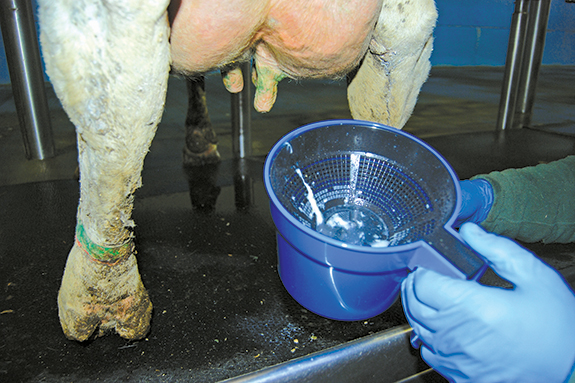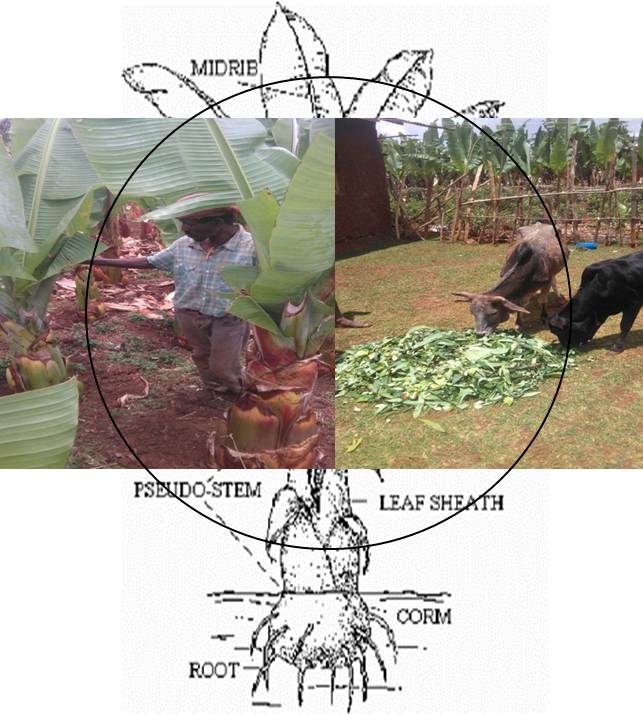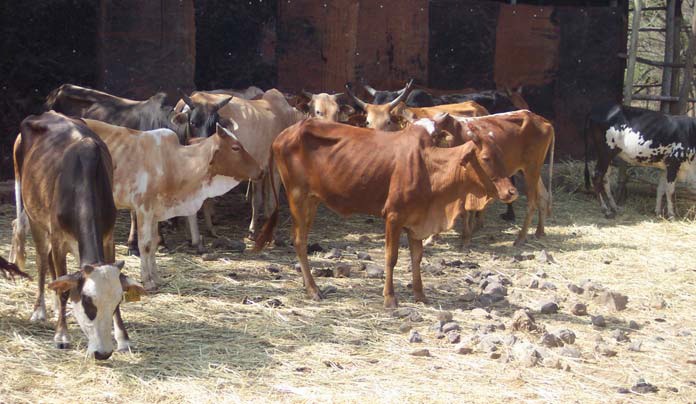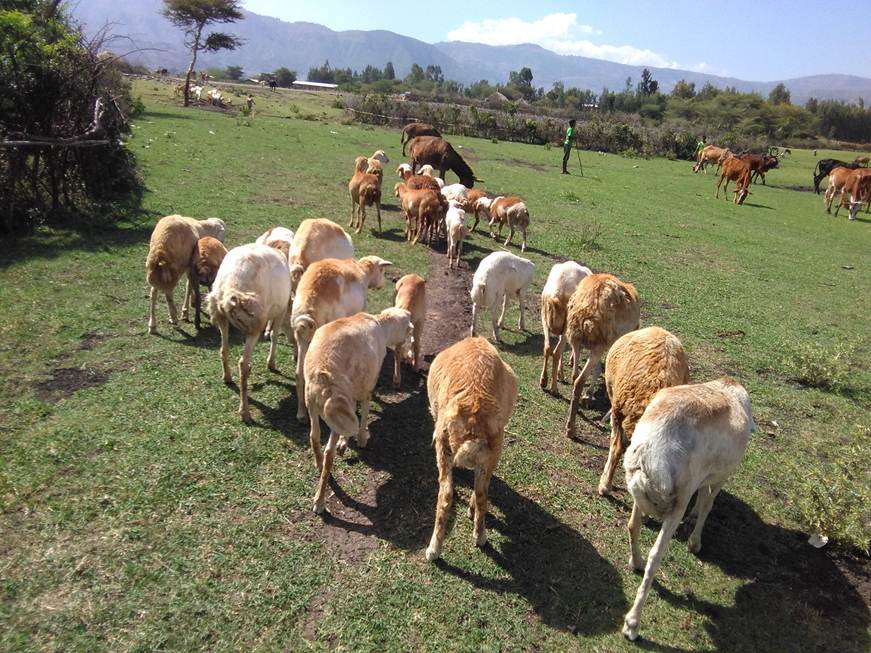Previous issue | Next issue | Archive
Volume 7 (5); September 25, 2017 [Booklet]
Research Paper
Enset (Enset ventricosum) beyond human consumption: opportunities and constraints as livestock feed in Gurage Zone, S-W Ethiopia.
Tilahun M.
Online J. Anim. Feed Res., 7(5): 97-104, 2017; pii: S222877011700016-7
Abstract
The objective of this study was to assess Enset (Enset ventricosum) plant as livestock feed resource; the opportunities and challenges of using Enset as livestock feed. This study used a descriptive and explanatory study design. A multi sample purposive sampling technique was employed. Ninety households who own livestock above 2 Tropical Livestock Unit from the district i.e., 30 Household respondents from each agro ecology were selected. The collected data were analyzed using SPSS 20 software, and ranked data was analyzed using Microsoft Excel. In addition, logit model [α = 0.05] was used to analyze and predict the values of dependent variables (Enset plant with livestock). Enset plant production (86.67%), livestock farming (83.3%) and perennial crop production (81.1%) took the lion share as means agricultural practices of the study area. Though natural pasture (Hebir) was ranked third in the highland of the study area, it was ranked first in the overall data gathered for available feed resource in the study area. Only 30(33.3%) of the respondents tried Enset conservation practices. From different Enset parts, leaf (Bera and Kessa) was ranked first as majorly used as livestock feed; midrib (Chimbina) and pseudo stem (Enkurkina) took second and third rank, respectively. The agro ecological difference estimated coefficient 0.698 (P = 0.046) suggested that agro ecology difference decrease the respondents number by 69.8 % to say no for Enset and livestock relationship. Respondents land holding had an estimated coefficient of 2.09 (P = 0.01) which suggested an increase in land holding by a timad (quarter of hectare) was increased Enset part use by 8.05%. Similarly, land used for Enset cultivation has an estimated coefficient of -3.37 (P = 0.01) which suggested an increase in the proportion of land use for Enset plant cultivation was decreased the use of Enset plant parts by 0.03%. From the different identified constraints of Enset plant use as livestock feed, land shortage, climate change, market access ranked first, second and third, respectively. It can be concluded that Enset is major part of livestock feed; gradual land shortage and other factors are hindering farmers not to use Enset as livestock feed and trust up on other cash crops. Most Enset harvesting is done at main rain season so conservation techniques is must, and has to be scrutinized based on agro ecological difference.
Keywords: Feed resource, Enset, Livestock, Enset Parts, Gurage zone
Productive and reproductive performances of local cows in Guraghe zone, South West Ethiopia.
Ayalew W and Feyisa T.
Online J. Anim. Feed Res., 7(5): 105-112, 2017; pii: S222877011700017-7
Abstract
In tropics the genetic diversity of indigenous livestock provides a range of options that are likely to be valuable in adaptation to poor-quality diets and tolerance of climatic extremes as well as resistance to specific diseases. The aim of this study was to assess productive and reproductive performance of local dairy cattle in Guraghe Zone. Formal survey was used to collect data from three district, which were selected from three agro-ecological zones namely, highland, midland and lowland. A total of 180 respondents (60 from each agro-ecology) that have at least one local milking cow were randomly selected. The data were analyzed by general linear model procedure of SPSS version 20 (SPSS, 2015). The breeding practices reported in the study area were mostly natural mating but AI also rarely practiced. In all agro-ecologies, farmers reported milk production as preferred trait, followed by reproduction, growth rate and longevity. In the follow up study, except agro-ecology all sources of variation had significant effect on morning and evening milk yields, however, the survey analysis revealed that agro-ecology was significant for all reproductive traits under this study. The average milk off-take of Guraghe highland cows was 1.7±0.02 liter/cow/day and on average cows gave a lactation yield of 379.14±12.11 liters/cow and an average lactation period of 7.90±0.08months. Overall mean of calving interval and days open were 22.03±0.37 and 12.70±0.37 months, while mean age at first service and age at first calving of cows in Guraghe Zone were quite late (33.51±0.70 and 42.85±0.70 months, respectively) even by local standard. In conclusion, this study has shown that performances of Guraghe highland cows less than the optimum values desirable for market-oriented dairy production. Therefore, there is a need for intervention to develop infrastructure, enhance input supply system and undertake appropriate breeding plan based on breeding objective and trait preferences of local farmers.
Keywords: Breeding objectives, Guraghe highland, Production and Reproductive traits
Research Paper
On-farm phenotypic characterization of Holla sheep types in South Wollo Zone Eastern Amhara Ethiopia.
Kefale A, Awoke T, Getu A and Abegaz S.
Online J. Anim. Feed Res., 7(5): 113-123, 2017; pii: S222877011700018-7
Abstract
The study was conducted from purposively selected districts of Kalu and Worebabu districts in South Wollo administrative zone to describe the physical characteristics. Confirmatory and purposive sampling techniques were employed to select the target farmers. Following that semi-structured questionnaire, focused group discussions, secondary data source analysis and field observations were used to generate the required information. In addition, simple random sampling technique was used to select 450 sheep. The study was performed based on field measurements and body measurements were taken from 450 sheep of both sexes. Majority of the Holla sheep have brown, coat color (59.2%) female and (49.5%) male and white coat color type (27.4%) for females and (31.8%) for males were observed and they are short, smooth coat cover and polled type. Whereas, about 4.4% of ewes had wattle while the rams had no wattle which was strongly influenced (P < 0.01) by pelvic width, tail width and ear length. Similarly body weight and chest depth were also influenced (P < 0.05) by district. Age group had significant effect (P < 0.05) on body weight and other body measurements. Average ±SE body weight age at 0PPI, 1PPI, 2PPI, 3PPI and 4PPI was recorded as 18.21±0.23 kg, 20.34±0.26 kg, 22.14±0.25 kg, 23.41±0.56 kg and 26.33±0.65kg, respectively. Sex was strong and significant (P < 0.01) effect on wither height, tail length and tail width. The interaction of sex and age is significantly (P < 0.05) influenced the liner body measurements except ear length of sheep. The highest relationship (r=0.74) between heart girth and body weight were recorded in Worebabu and Kalu district of female age groups at 2PPI. So, chest girth is the first variable to enter in to stepwise regression model in both male and female sheep type. Present phenotypic information could be complemented with genetic analysis, and serve as a basis or designing appropriate conservation, breeding and selection strategies ‘for Holla sheep.
Keywords: Body measurement, Characterization, Holla Sheep, On farm, Phenotypic Ethiopia
 Research Paper
Research Paper
Prevalence of bovine subclinical mastitis and its associated risk factors in Addis Ababa, Ethiopia.
Yilma M and Samuel D.
Online J. Anim. Feed Res., 7(5): 124-133, 2017; pii: S222877011700019-7
Abstract
A cross-sectional study was conducted with the objective of determining the prevalence of bovine Subclinical mastitis (SCM) in dairy cows and assessing its associated potential risk factors from November, 2016 to April, 2017 in Addis Ababa, Central Ethiopia using California mastitis test. A total of 390 lactating cows comprising different cattle breed from sixteen dairy farms were purposively sampled. The overall prevalence of SCM among the study animal was 49.23 % (192/390). Of this, the highest prevalence of SCM was observed in Holstein-Friesian (51.6%) followed by Jersey (50.0%) and cross (37.1%). The prevalence of SCM in <5 months, 5-8 months and >8 months stage of lactation was 73.9%, 38.5% and 47.5%, respectively. In terms of milk yield, the prevalence of SCM was higher in cows having more than 15 liters of milk production (61.5%) and 7-15 liters (45.8%) and lower in <7 liters (41.4%). The prevalence of SCM in parity group 1-3, 4-6 and >6 was 41.3%, 52.9%, and 78.7%, respectively. Regarding floor type, the highest prevalence was recorded in bad concrete floor (64.2%) than good concrete (43.7%). The prevalence of SCM was higher in cows having teat lesion (75.3%) than no teat lesion (42.4%). Breed, parity, stage of lactation, milk yield, teat lesion, floor type were found to have statistically significant difference (P<0.05). However, age, towel usage and body condition score showed non-significant difference (P > 0.05). In general, Subclinical mastitis was a major health problem of dairy cows in the study area. Therefore, more emphasis should be given on regular screening of cows, designing effective control and prevention strategies for subclinical mastitis.
Keywords: Addis Ababa Dairy cows, Prevalence and Risk factor, Subclinical mastitis
Previous issue | Next issue | Archive
This work is licensed under a Creative Commons Attribution-NonCommercial 4.0 International License.
| < Prev | Next > |
|---|






